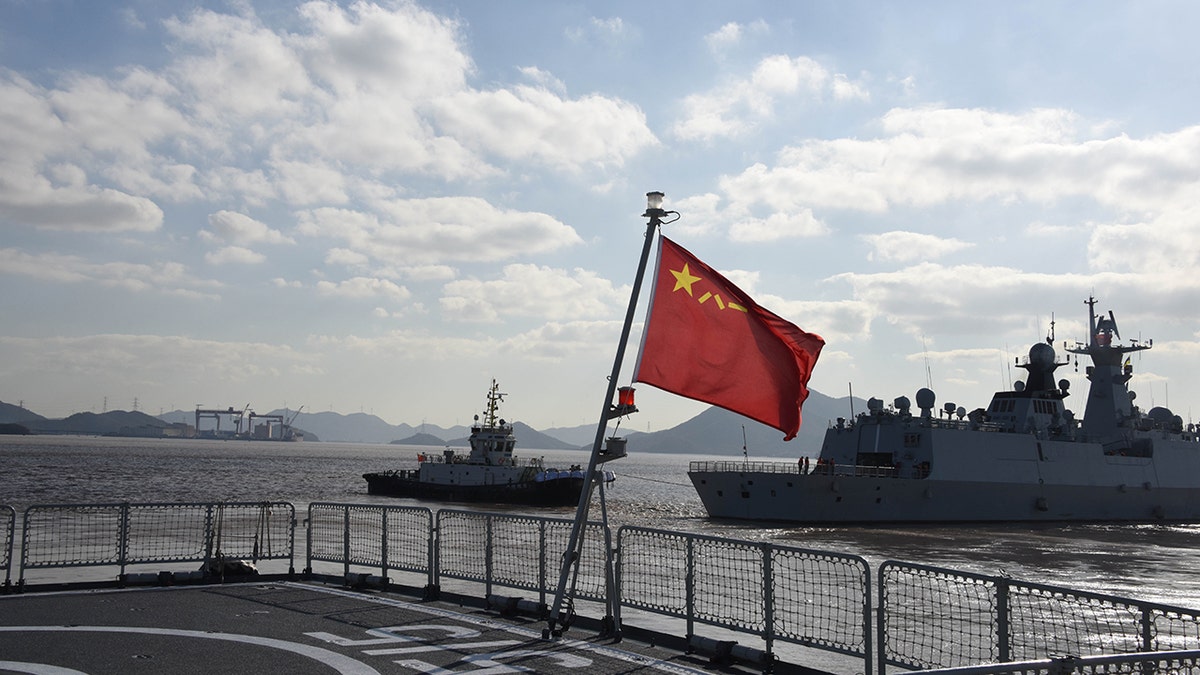Timing of Taiwan troop announcement 'sends a signal' to China: James Carafano
The Heritage Foundation VP of foreign and defense policy studies James Carafano reacts to the U.S. expanding its troop presence in Taiwan on 'America Reports.'
The Philippines and Taiwan sounded alarm bells after detecting dozens of suspected Chinese vessels and aircraft across the South China Sea on Friday.
"To undermine the Taiwanese public’s faith in the ability of the armed forces to protect the island’s sovereignty, China’s near-daily aerial and naval incursions will probably increase in number and intensity over the course of the coming year," Craig Singleton, a senior fellow at the Foundation for Defense of Democracies, told Fox News Digital.
The Taiwanese Ministry of National Defense issued a statement saying that it had detected 37 People’s Liberation Army (PLA) aircraft and six PLA Navy vessels around Taiwan at around 6 a.m.
An update noted that 12 of the aircraft had crossed the median line of the Taiwan Strait and entered Taiwan’s air defense identification zone.
US SENDING UP TO 200 MORE TROOPS TO TAIWAN AS CHINA TENSIONS GROW
The island responded by dispatching aircraft and naval vessels to monitor the Chinese crafts.
Around the same time, the Philippine Coast Guard (PCG) issued a statement claiming that a patrol aircraft had spotted at least 26 suspected Chinese "maritime militia vessels" during a flyover of the South China Sea.

A Chinese navy fleet departs for an upcoming China-Russia joint naval exercise from a military port in Zhoushan, east China's Zhejiang Province, Dec. 20, 2022. Chinese and Russian navies will hold the joint naval exercise "Joint Sea 2022" in waters east of the sea area from Zhoushan to Taizhou, east China's Zhejiang Province, starting from Dec. 21, according to the Chinese navy. (LiLi Yun/Xinhua via Getty Images Yun/Xinhua via Getty Images)
The vessels were spotted within the Philippine exclusive economic zone, which the Philippines has exclusive rights to the sea resources, Radio Free Asia reported.
The plane "received inaudible radio challenges, both in English and Chinese from CCG-5304 [a Chinese vessel] currently continuing to maintain presence in the area," the PCG said in a statement.
PENTAGON SAYS MAJORITY OF DOWNED CHINESE SPY CRAFT FOUND
Reporters aboard the flight said they heard warnings that the plane was "entering the vicinity of Chinese territory" and was requested the leave the area.
"These latest exercises are broadly consistent with the 'new normal' China established in the region after former House Speaker Nancy Pelosi's travel to Taiwan last August, in which China now regularly conducts military maneuvers much closer to Taiwan’s shores," Singleton explained.

Chief of Naval Operations Admiral Michael Gilday speaks during an interview with the media at a private hangar in Manila, Philippines, on Feb. 22, 2023. The United States is "committed" to conducting joint maritime patrols with the Philippines in the disputed South China Sea, said Gilday as the countries seek to deter Chinese aggression. (Ted Aljibe/AFP via Getty Images)
"All told, China doubled its annual incursions into Taiwan’s air defense zone from 538 in 2021 to 1,241 in 2022," he continued. "Likewise, China intensified its cyber-attacks against Taiwanese governmental and financial institutions, as well as launched disinformation campaigns aimed at subverting Taiwan’s political process."
"Xi’s problem in all this—which he may not yet realize—is that China’s aggressive attempts at sub-crisis maneuvering could have the unintended effect of catalyzing the very superpower crisis he seeks to avoid," Singleton concluded. "Gaming out gray zone escalation suggests such provocations could lead the United States and its allies to embrace more forceful counter-responses in the future."
11-YEAR-OLD CAMBODIAN GIRL DIES FROM BIRD FLU IN COUNTRY'S FIRST KNOWN HUMAN INFECTION SINCE 2014
China’s military activity in the region follows reports that North Korea test-fired long-range cruise missiles off its eastern coast on Thursday. Pyongyang’s official Korean Central News Agency said the four missiles flew for nearly three hours after being launched from the northeastern coast, drew oval and figure-eight patterns above the sea, and showed they can hit targets 2,000 kilometers (1,240 miles) away.
The launches, initially reported by Pyongyang and later confirmed by South Korea’s military, were intended to verify the reliability of the missiles and the rapid response capabilities of the weapons. South Korea’s joint chiefs of staffs said the details described by North Korea "had discrepancies," but did not elaborate.

A Chinese Air Force H-6K bomber flies to the West Pacific, via the Bashi Strait, for a routine combat simulation drill, Sept. 12, 2016. The Chinese Air Force on Monday sent multiple aircraft models, including H-6K bombers, Su-30 fighters, and air tankers, for the drill. The fleet conducted reconnaissance and early warning, sea surface cruising, inflight refueling, and achieved all the drill's targets. (Xinhua/Guo Wei via Getty Images)
The launches came as the U.S. and South Korean defense officials held a Deterrence Strategy Committee Table-Top Exercise (DSC TTX) at the Pentagon. A day before that, North Korea launched a Hwasong-15 intercontinental ballistic missile, with Kim Jong Un's sister saying that they were "using the Pacific" as their "firing range."
"Given the DPRK’s recent aggressive nuclear policy and advancements in nuclear capabilities, the TTX scenario focused on the possibility of the DPRK’s use of nuclear weapons," the Pentagon said Thursday.
Tensions in the region have increased after the U.S. held joint training exercises with Britain and Australia to strengthen air defenses against Chinese aircraft.
CLICK HERE TO GET THE FOX NEWS APP
The joint exercise, dubbed Red Flag, lasted for three weeks, giving pilots the chance to practice combat against peer and near-peer technology. The exercises included F-22s, F-35s, B-52s, F-16s and C-130s based out of Nellis Air Force Base.
"[China is] just the pacing challenge that we train to so that we're ready ... We think that if we're ready for China, we're ready for anybody," U.S. Air Force Colonel Jared Hutchinson told Reuters.
Anders Hagstrom and The Associated Press contributed to this report.

